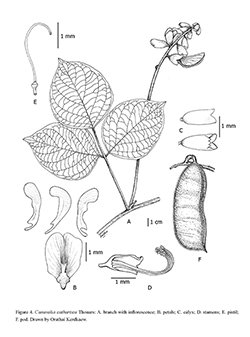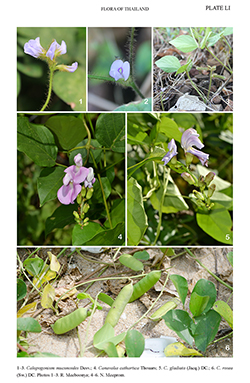e-Flora of Thailand
Volume 4 > Part 3.3 > Year 2023 > Page 510 > Leguminosae-Papilionoideae > Canavalia
1. Canavalia cathartica Thouarswfo-0000189794
J. Bot. Appl. 1(2): 81. 1813 [as Canavali catharticus]; J.Sauer, Brittonia 16(2): 158. 1964; Verdc. in Milne-Redh. & Polhill, Fl. Trop. E. Africa, Legum. (Part 4): 574, f. 84. 1971; Kew Bull. 42(3): 659. 1987; T.C.Huang & H.Ohashi in H.L.Li et al., Fl. Taiwan 3: 193. 1977; Thuân in Aubrév. & J.-F.Leroy, Fl. Cambodge, Laos & Vietnam 17: 76. 1979; Rudd in Dassanayake & Fosberg, Revis. Handb. Fl. Ceylon 7: 275. 1991; T.L.Wu & Thulin in C.Y.Wu et al., Fl. China 10: 199. 2010; Meeprom & Ngerns., Thai J. Bot. 10(1): 4. 2018.— Dolichos virosus Roxb., Hort. Bengal.: 55. 1814, nom. nud.; Fl. Ind., ed. 3: 301. 1832, p.p.; Walp., Repert. Bot. Syst. 1(4): 765. 1842, p.p., quoad Rheede, Hort. Malab. 8, t. 45.1688.— Canavalia virosa (Roxb.) Wight & Arn., Prodr. Fl. Ind. Orient. 1: 253. 1834, p.p.; Walp., Repert. Bot. Syst. 1(4): 766. 1842, p.p.; Verdc. in Milne-Redh. & Polhill, Fl. Trop. E. Africa, Legum. (Part 4): 573. 1971. Fig. 4. Plate LI: 4.
Accepted Name : This is currently accepted.
Synonyms & Citations :
Description : Herbaceous climber, twining right or prostrate with capability to twine; stems terete, sparsely hairy to glabrous. Stipules lanceolate, 2–3 by ca 1 mm, apex acute, base obliquely auriculate or rounded, margin entire, outside densely hairy, inside glabrous. Leaves spiral or alternate; petioles 2.5–8.5 cm long, sparsely hairy, pulvinus densely hairy; rachis 1–3 cm long, sparsely hairy. Leaflets: petiolules 3–7 mm long, densely hairy to glabrescent; blade chartaceous to subcoriaceous sometimes undulate, becomes thinner when dry, broadly ovate, elliptic-ovate, ovate or suborbicular, 4.5–12 by 3.5–8 cm, apex acuminate to acute, base rounded, subcordate or cuneate, margin entire, both surfaces sparsely hairy; lateral veins 4–8 pairs; stipels subulate, 0.5–2 mm long, persistent or caducous. Inflorescences decurved, 12–40 cm long with 6–25 swollen nodes; peduncles 7–20 cm long, glabrescent; axis 2–15 cm long, sparsely to densely hairy. Flowers pale pink to pale purple, mildly fragrant; pedicels 1–3 mm long; bracteoles broadly ovate, small, caducous. Calyx light green, 1.2–1.8 cm long, outside sparsely to densely hairy, inside densely hairy; tube 1–1.4 cm long, 7–9 mm in diameter; upper lip 2-lobed, lobes semicircular, 3.5–8 by 5–7 mm; lower lip 3-lobed, lobes triangular, 1–2.8 by 0.5–2.8 mm. Corolla: standard obcordate, 3–3.7 by 1.8–2.8 cm, apex cleft, base clawed, 6–9 mm long, margin revolute; wings free, ligulate, 2.3–3.3 by 0.4–1 cm, curved, apex rounded, base clawed, 6–9 mm long, margin entire, undulate; keel 2.5–3.4 by 0.6–1 cm, apex rounded to obtuse, base free, clawed, 6–9.5 mm long. Stamens: filaments 2.2–4 cm long; anthers 2–3 by 1–2 mm. Ovary oblong, 1–1.6 cm long, laterally compressed, densely hairy, base stipitate, 3–6 mm long; style 0.5–2 cm long, proximal portion densely hairy, distal portion glabrescent; stigma capitate, glabrous; disc annular, 2.3–2.8 mm in diameter. Pods 5–10-seeded, oblong, 6.5–15 by 2–4.5 cm, 1.5–2.5 cm thick, slightly curved, turgid, green, turning brown to dark brown with age, additional ribs 2.5–4(–8) mm away from the ventral suture, tip beaked, 2–5(–7) mm long, base stipitate, 0.6–1(–1.5) cm long, valves leathery, twisting upon dehiscence, exocarp rough, glabrescent to glabrous; fruit stalk 2–7 mm long, thick. Seeds ellipsoid, 1.3–1.8 by 0.9–1.2 cm, 0.6–0.8 cm thick, slightly laterally compressed, brown to dark brown, sometimes with dark brown marbling, glabrous; hilum linear, 0.9–1.2 cm long.
Thailand : SOUTH-WESTERN: Prachuap Khiri Khan (Bang Saphan, Sam Roi Yot NP); CENTRAL: Phra Nakhon Sri Ayutthaya (Wat Bang Phloeng); Nakhon Pathom (Mahidol University, Salaya Campus); Pathum Thani (Lat Lum Kaeo); Nonthaburi (Bang Bua Thong, Bang Rak Noi, Sai Ma); Krung Thep Maha Nakhon (Bangkok) (Bang Khen); Samut Prakan (Bang Pu, Phra Pradaeng); SOUTH-EASTERN: Chachoengsao (Bang Nam Priao); Chon Buri (Ko Chan, Ko Si Chang, Hat Nang Ram); Rayong (Hat Mae Ram Phueng, Khao Laem Ya); Chanthaburi; Trat (Klong Yai, Ko Chang, Ko Kradat); PENINSULAR: Chumphon (Pathio, Sawi); Ranong (Ko Chang, Hat Praphat); Surat Thani (Kanchanadit, Ko Pha Ngan, Ta Chang); Phangnga (Thai Mueang); Krabi (Ao Nang, Ko Lanta); Nakhon Si Thamarat (Khanom, Hua Sai, Si Chon), Phatthalung (Thale Noi); Trang (Hat Ratchamongkhon), Hat Pak Meng, Hat Wiwa Tai Samut); Satun (Khao Ban, Ko Tarutao); Songkhla (Hat Yai, Ko Khop, Krasae Sin, Phang La, Suan Tun Waterfall).
Distribution : Paleotropics and Pacific Islands (Réunion – type).
Ecology : Open or disturbed areas, or roadsides in beach forest, mangrove forest, or near fresh water resources, 0–15 m alt. Flowering and fruiting: November–December.
Vernacular : Thua chingcho (ถั่วจิงจ้อ), thua fak khrok (ถั่วฝักครก), thua kalok (ถั่วกะลก), thua khla (ถั่วคล้า), thua krapao (ถั่วกระเป๋า), thua phi (ถั่วผี).


